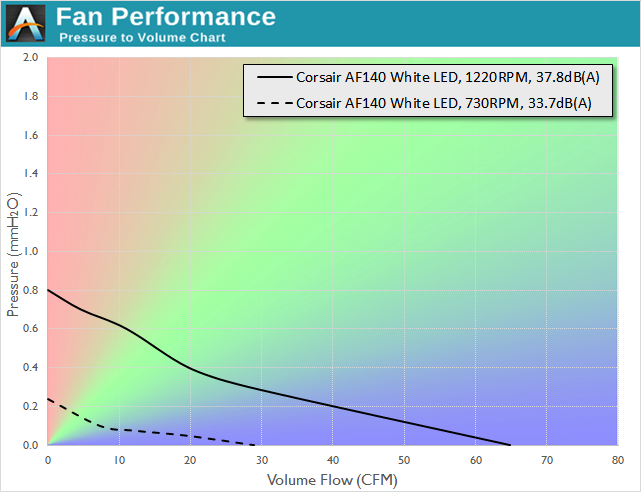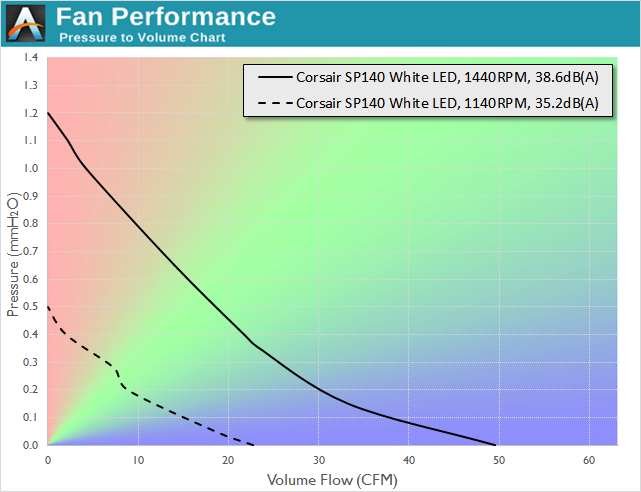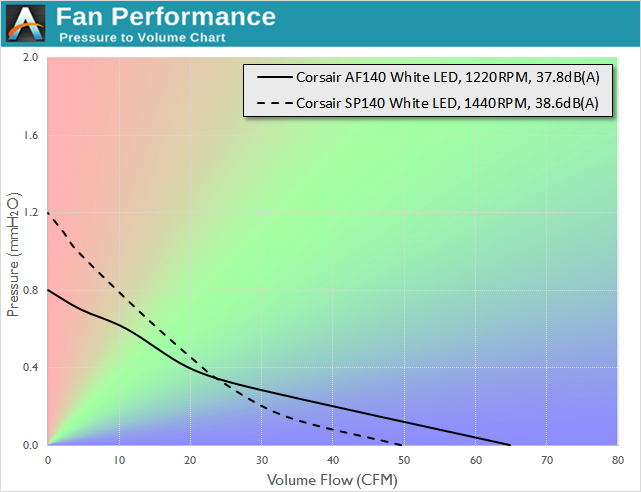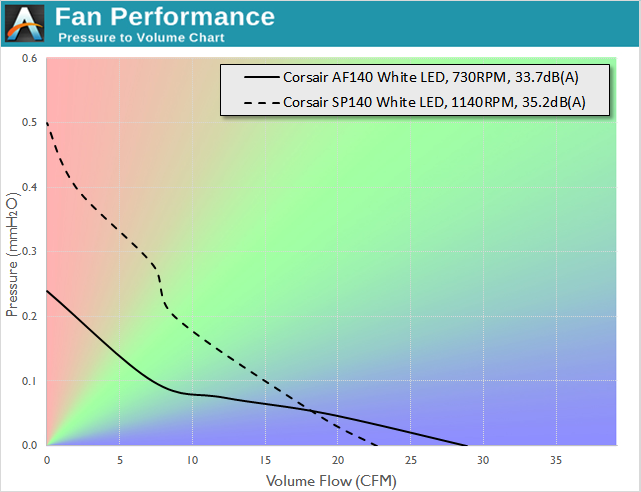The Corsair SP (Static Pressure), AF (High Airflow) 120/140mm Fan Review
by E. Fylladitakis on November 25, 2015 8:00 AM ESTCorsair's 140mm Performance
AF140 White LED Quiet Edition
As mentioned previously, the variation on Corsair's fans means that this one is our 140mm model in the 'High Airflow' (AF) category, focusing on low-impedance (case-fan style) scenarios. The LED versions are not built as sturdy as the non-LED models, and this one comes in with the 'Quiet Edition' moniker as well. Here are the results for the AF140 LED QE fan at high and low voltage settings:
As it can be seen from the above performance chart, the AF140 begins with very low static pressure readings but its airflow increases as the airflow impedance decreases. This increase is dramatic when the airflow impedance pressure drop is below 0.3 mmH2O while the fan is operating at its maximum speed.
SP140 White LED
The Static Pressure line of fans focuses more on the early end of the pressure/volume curve, aiming to get higher airflow at the same pressure while potentially sacrificing the total peak volume flow at zero pressure. Similar to the AF model above, this is a 140mm LED version but not in the quest range. Here are the 12V and 7V results:
As expected by its design and specifications, the SP140 has a good static pressure, nearly 50% better than that of the high airflow AF140. However, its pressure to flow curve declines faster and the SP140, even though it has a higher maximum speed than the AF140, cannot reach very high airflow values.
Comparing the AF140 LED QE and SP140 LED
If we do a direct comparison at the different voltage modes, we get the following for 12 volts:
Then this is for 7 volts (note the different scales on both axes):
Note that their rotational speeds are not the same at either voltage. Still, the slower AF140 can move greater volumes of air when the airflow impedance pressure drop is below 0.3 mmH2O. However, if the airflow impedance is high, the SP140 will clearly provide better performance.














92 Comments
View All Comments
RdVi - Wednesday, November 25, 2015 - link
A nice introduction to a more in depth investigation of real world fan performance. I hope to see many more articles like this one with comparisons between brands where possible. Great work.Valantar - Thursday, November 26, 2015 - link
Agreed, this was an interesting and informative read. Looking forward to some comparisons, especially high-end brands like Noctua, to see what value you're actually getting from the extra outlay.maximumGPU - Wednesday, November 25, 2015 - link
Thank you for setting the record straight in regards to the LED models. At first look anyone could be fooled that these are the standard models with some led's strapped in.inighthawki - Wednesday, November 25, 2015 - link
With that in mind, is there a reason the LED versions are built differently? That is, the article mentions the difference in the fan blades, but I'm wondering why there is a difference.ninjaquick - Wednesday, November 25, 2015 - link
Ask Corsair.tipoo - Wednesday, November 25, 2015 - link
Just a misanthropic guess, but saving pennies to make up for the LED?TheKiwi - Thursday, November 26, 2015 - link
I actually asked (well, kinda angrily ranted) at a Corsair product manager on IRC about that once. Basically, people buying LED fans don't care about high-end performance as much. There's no market for high-end LED fans.I think it's dumb, but they probably have market research to back it up.
Barbarossa - Thursday, December 3, 2015 - link
Corsair George here - this is pretty close to right, or at least it was at the time of the product dev 2-3 years ago. When we started doing fans in 2012 we had no data that proved that "high cost" LED fans sold at all. Basically, if it had LEDs in it, nobody paid a premium. At the time the best fans were Noctua or Scythe, neither of which used LEDs.So when we decided to do performance LED fans, we focused on making them perform very well for their price. Note that the LED fans do not include the swappable color rings or the rubber corners or the hydraulic bearings - all cost saving measures because LED fans had to cost significantly less.
Nowadays, with a few more higher-cost LED options, we are somewhat rethinking that.
I think there's room for a truly high performance LED fan out there - if it doesn't look and feel cheap.
Also, it's been almost 4 years since we released the SP / AF performance fans - I think we're about due for something new.
Phreedom1 - Sunday, December 6, 2015 - link
Awesome explanation George. Hope Corsair does come out with a new fan product.rscsrAT - Wednesday, November 25, 2015 - link
It's nice to see a fan review again.But I think that the presentation is awful. You should add scale lines for the different cooler types instead of the color gradients. Then it would actually be useful.
And the word impedance should be limited to electrical resistance. I am studying mechanical engineering and I haven't heard impedance once (in fluid dynamics). It is usually refered as resistance (or drag for bodies in free flow).